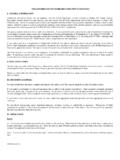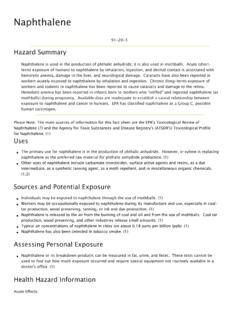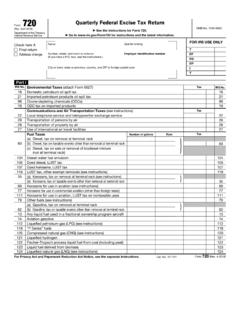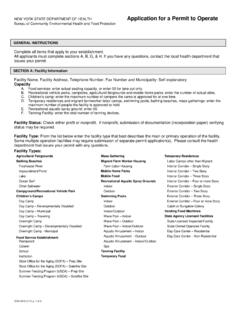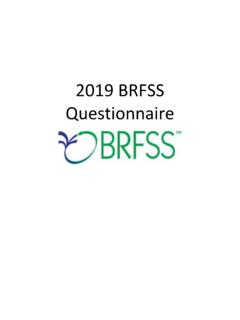Transcription of Impact of Substance Abuse on Academic Performance among ...
1 Journal of Education and Practice ISSN 2222-1735 (Paper) ISSN 2222-288X (Online) , , 2015 108 Impact of Substance Abuse on Academic Performance among Adolescent Students of Colleges of Education in Kwara State, Nigeria Muritala Ishola AKANBI1 Godwin Augustina2 Anyio Bahago Theophilus3 Muhammad Muritala4 Ajiboye Stephen Ajiboye4 of Educational Psychology and Counselling, Ahmadu Bello University, Zaria,Nigeria of Educational foundations, Taraba State University, Jalingo, Nigeria of Educational Psychology, Federal College of Education, Zaria of Educational Psychology and Counselling, Ahmadu Bello University, Zaria.
2 Nigeria Abstract The study investigated the Impact of Substance Abuse on adolescent on Academic Performance in colleges of education in Kwara The design used for the study was the survey. A sample of 150 adolescent students was randomly selected form selected departments in three colleges of education in the State. A validated instrument, Drug Habit Inventory (DHI, Fayombo, 1998) was used to collect relevant data and objective tests on Educational and General Studies were also used to test Academic Performance of these students. The data collected was analyzed using a t-test to analyse the hypotheses of differences. The findings show that there is significant difference between the Academic Performance and students who Abuse drugs and those who do not and there is significant gender difference among adolescent Substance abusers on the basis of Academic Performance .
3 Based on the findings, recommendations were made on campaigns against Substance use should be incorporated in health education curricula of colleges of education with special focus on the adverse consequences of the substances used and establishment of Counselling Centres for Drug Control: Counselling centres should be established in every colleges of education by the government or private individuals. Keywords: Substance Abuse , Drug, Adolescence, colleges of education. Introduction The use of hard drugs by adolescent students in Nigerian colleges of education has become an embarrassing occurrence to parents, schools, government authorities, and the society at large.
4 The constant Abuse of drugs among this group of students can cause psycho-social problems in society. One may hope that this hateful practice and its associated problems would not lead to the breeding of deranged generation of youths. This fear is not speculative because of what happens to be the frequent and rampant drug crises in many Nigerian educational institutions. Adolescence is a period of changeover from childhood to adulthood and this critical developmental period is marked by several physical, psychological and social changes. Adolescents are a segment of population with age range between 14-25years. Most students in colleges of education in Nigeria are usually within the adolescent age range of 14-25 years (Olugbenga-Bello; Adebinpe; Abodurin, 2009).
5 Adolescence is a time of experimentation, exploration, curiosity and identity search. Part of such a quest involves some risk-taking, including the use and Abuse of psychoactive substances, which are the drugs that apply their major effects on the brain resulting in sedation, encouragement or change in mood of an individual. Adolescents are faced with the huge task of establishing a sense of identity. The new cognitive skills of maturing adolescents give them the ability to reflect on who they are and what makes them unique. Identity is made up of two components, self-concept and self-esteem (American Psychological Association, 2002). Self-concept is a set of beliefs about oneself, including attributes, roles, goals, interests, values, religious and political beliefs, while self-esteem is how one feels about one s self-concept.
6 All of the developmental changes that adolescents experience prepare them to experiment with new behaviours. This experimentation results in risk-taking, which is a normal part of adolescent development (Sue, et al, 2009). Engaging in risk-taking behaviour helps adolescents to shape their identities, try out their new decision-making skills and gain peer acceptance and respect (Ponton, 2009). Unfortunately, some of the risk that adolescents take may pose a real threat to their health and well being. These include pregnancy, cigarette smoking, excessive alcohol consumption and drug Abuse . Odejide (2000) posited that drug is said to be abused when its use is not pharmacologically necessary especially when used in the face of legal prohibition or when a socially acceptable beverage is used excessively.
7 Sambo, (2008) viewed that chronic use of substances can cause serious and sometimes irreversible damage to adolescent s physical and psychological development. A drug refers to a Substance that could bring about a change in the biological function through its chemical actions (Okoye, 2001). It is also considered as a Substance that modifies perceptions, cognition, mood, behaviour and general body functions (Balogun, 2006). This could thus be considered as chemical modifiers of Journal of Education and Practice ISSN 2222-1735 (Paper) ISSN 2222-288X (Online) , , 2015 109 the living tissues that could bring about psychological and behavioural changes (Nnachi, 2007).
8 Drug Abuse is a major public health problem all over the world (UNODC, 2005). The use and Abuse of drugs by adolescents have become one of the most disturbing health related phenomena in Nigeria and other parts of the world (NDLEA, 1997). Several school going adolescents experience mental health problem, either temporarily or for a long period of time. Some become insane, maladjusted to school situations and eventually drop out of school. NAFDAC, (2004) as cited by Haladu (2003) explained the term drug Abuse as excessive and persistent self-administration of a drug without regard to the medically or culturally accepted patterns. It could also be viewed as the use of a drug to the extent that it interferes with the health and social function of an individual.
9 Odejide, (2000) warned that drug abusers who exhibit symptoms of stress, anxiety, depression, behavior changes, fatigue and loss or increase in appetite should be treated by medical experts and conusellors to save them from deadly diseases. The alarming evidence in the prevalence of drug Abuse , the effects and consequences of Substance Abuse among students has called for concern and challenge to all helping professions to mount strategies of equipping youths with skills of living devoid of Substance Abuse . In Kwara State today, the consequences of Substance use are diverse, including acute and chronic health, social as well as psychological problem.
10 There is disruption of interpersonal relationships particularly within the family, marginalization, criminal behaviour, school failure, vocational problems and failure to achieve normal adolescent milestones, yet these adolescents are expected to be the leaders of the country in the future when they do not even have any focus for the future. Several studies carried out among the colleges of education students in Benin City by Omage and Oshiloya, (2006), Nwagwu, (1999), Fayombo, (2000) and Obianwu, (2005) found out that students and youth of easy virtue in the community are involved in cannabis Abuse and stimulants such as amphetamines and cannabis. The consensus of opinion therefore seems to be that youths are also seriously involved in Substance Abuse .










